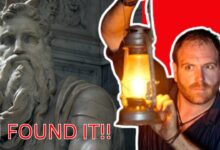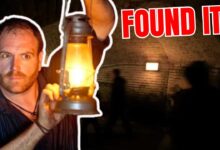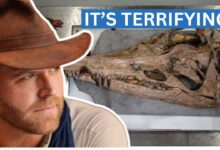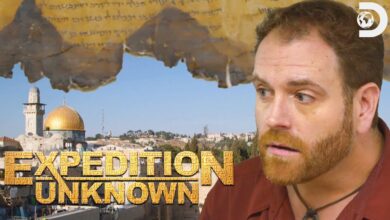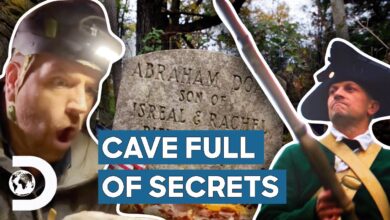Intrusive Burial Found Inside Egyptian Noble’s Tomb! | Expedition Unknown
Intrusive Burial Found Inside Egyptian Noble’s Tomb! | Expedition Unknown

Let’s start here because in here he lists all of his titles. This is his resume. Yes, absolutely.
Okay, at a tomb near Luxor, dated from Egypt’s chaotic First Intermediate Period, Dr. Inz Torres is helping me understand how the ancient Old Kingdom descended into a Dark Age.
Okay, who is he? So he tells us that he is a dignitary. Sure. Um, a governor. Okay, a royal seal bearer, and that’s important. And he also tells us he is the regional ruler and a bit of a bragger. He is, and in fact, next to his titles, he tells us that he is the beginning of men and the end of men, and that no one like him was ever born nor will he be.
I say that though, sometimes that’s on my business card. Actually, is that inappropriate? I not have that on there?
It’s incredible to think that we go from this iron grip on power that the pharaohs seemed to have in the Old Kingdom to people building these lavish tombs for themselves. It’s a huge shift.
Absolutely, but the decline in the pharaoh’s absolute authority is only part of the story. The walls of Ani’s tomb reveal another reason the Old Kingdom fell apart.
So, when we get to this column, we see Ani telling us a little bit about possible historical events. He’s highlighting a period of crisis. He tells us that the entirety of Upper Egypt was dying of hunger, and every man was eating his child. And probably saying that metaphorically, like they have no food.
Absolutely. References to this famine appear in multiple tombs from this period. In addition, scientists have conducted sediment tests showing that around 2200 BCE, at the time of the collapse of the Old Kingdom, certain lands around the Nile were bone dry. The start of a decades-long drought.
Add to that governors like Atifi with growing power and a need to feed people in their own region, and things get dangerous.
So this kind of feels like a powder keg, because now you’ve got power in the hands of lots of different people, you’ve got a scarcity of food, you’ve got a drought, and these regional rulers are controlling resources.
Yes, absolutely. Those are typically, historically, the conditions for war.
Yes, and in fact, elsewhere in this tomb, Ani tells us how he’s been at war against enemy coalitions of different regions, and it shows that there were fights for power within Egypt among these regional leaders.
Right, the tombs we’ve explored in Sakara, those belonging to Yarat Hui and Henu, show the road to Ani’s time—a time when the pharaoh is no longer in control of his kingdom, and a kingdom in dire need of food, water, and security for its people.
To see how those puzzle pieces fit into the tombs we’re continuing to explore, I head from Luxor back to Sakara for one last trip to our dig site to excavate the final layers of this mystery.
I descend down into the impressively painted tomb that belonged to Hu, a mayor in the time of Pharaoh Merne-Re. The excavations have progressed further down so that the finer archaeological work can continue.
Okay, I’m alive. I’m alive. Okay, so some real progress here. This is not what I expected to see here. Blocking half the tomb, here we have this mud brick wall.
And have any of the tombs here had this?
No, in this side, it’s a very rare feature here. It’s not common to find something like this.
Is this feature part of the original tomb, do we think, or is it later?
I think it’s later, but not much later. So, still in antiquity, someone added this shortly after the tomb.
Yes, so does that mean this tomb has been reused? Maybe?
Alright, the mystery continues. More digging.
Yes, for this kind of excavation in tight, dusty spaces, we need to use respirator masks to protect our lungs.
So this is kind of a tedious part of the process. We’re literally going to scrape sand from the back of the vault toward the front and just take it down like an inch at a time.
Oh, Jos got something.
Yes, hold on, he’s got something here. Something painted.
Yes, it’s an offering.
An offering? Yes, it’s a goose.
It’s a goose? Yes, look at the wing, and this is the neck, kind of offering. It’s a kind of offering.
So, this would have been a small carved limestone statue, carved into the shape of a goose, and left as an offering.
Wow. And you can imagine he tried to imitate the yellow color with the skin of the goats, right? And so, this is the neck and the head of the goose, bent backward.
Uh-huh. This offering brings us back to the original tomb, right?
Okay, start again. Remember when you were a kid and you used to play in the sand at the beach? It’s just like that, except there might be a human corpse under here.
It’s a lot of sand. I can almost sit up, which is an improvement.
Right. And then, I find something that makes me sit up here. Here, here, here.
Is that wood or a bone?
Bone. Piece of bone.
Piece of bone? Yes, long bone.
Okay, human remains.
Here, looks like we’ve got another long bone here. Another long bone here.
So we’ve got a burial up against this wall here.
This is a—Is that a foot?
Foot? Got part of the foot here. It looks like both feet. Both feet!
Oh my word. Oh man, look at this. So we’ve got a body that’s laid out this way along the edge of the tomb.
So this is definitely an intrusive burial.
Yes, intrusive burials were a common practice in ancient Egypt. People would break into tombs, discard the original resident, and reuse the space for their loved ones, by surrounding them with offerings and spells—even from someone else’s tomb. The belief was that this might have ensured a journey to the afterlife.
We’ve got somebody that was laid here in the tomb after the owner, and no sign of a coffin.
Yes, this skeleton looks like it’s going kind of down at an angle, so it may be that the rest of him is laid out right under here.
We can see traces of linen on the leg bone, so this is a mummy, obviously in a really, really bad state of preservation. He was mummified and placed here, but definitely after the owner of our tomb.
This is one of the ribs.
Uh-huh.
Got a whole body here, except for a head. Where’s his head?
Oh, hold on, we have a skull in the burial shaft of a Sixth Dynasty Egyptian noble named Henu. We’ve discovered an uninvited guest—an intrusive burial laid to rest after the tomb’s owner.
Top of the skull here, coming into view. Look at his mouth, look at the preservation.
No, it’s coming into view here. This body shows the mummification techniques that were the norm for the Old Kingdom.
So this really is an Old Kingdom mummy. Here, we have a lifelike appearance, but it’s almost molded on. You can see the way his lips are, the way his nose is preserved. We don’t see any of those resins, any of those advanced techniques we would see later.
So, very much like the mummy of Nefer that we saw.
There’s something just overwhelming about digging down through this sand and just coming—literally coming face to face with a person.
It’s meeting someone from the past.
So we’ll dig this out a bit more and then photograph it.
Yes. The remains are quickly and carefully removed so we can continue digging down toward Hu’s burial layer.
[Music]
Oh, hold on. Got some wood here. Could this be from the coffin, from the original coffin of Hu?
You think so?
Yes. We are now, we are in the layer down, the burial.
Right, so we’re at the burial layer now. So his burial is definitely disturbed then.
Yes, you see that man who came after Hu, his poor man. He just put his body above the sand.
Right, so if we have a wooden coffin, we must find something around his mummy, but we have nothing. So, the mummy we found earlier—the later mummy—he came in here and what destroyed this coffin?
Yes.
We think of these tombs as such sacred places, as the ancient Egyptians clearly had such respect for the afterlife, for their religion, for their gods. Yet, they were willing to come in and desecrate a tomb like this for themselves.
This is the end of the Old Kingdom in a nutshell—traditions thrown aside as chaos reigns. But you can imagine, if this man was desperate, right? He’s desperate. He comes here, destroys the original burial to make an afterlife for himself.
Yes, the great Hu. Yes, he was the mayor. He was the sole friend of the king. He was this powerful guy in the palace. And it all comes to this.
[Music]
